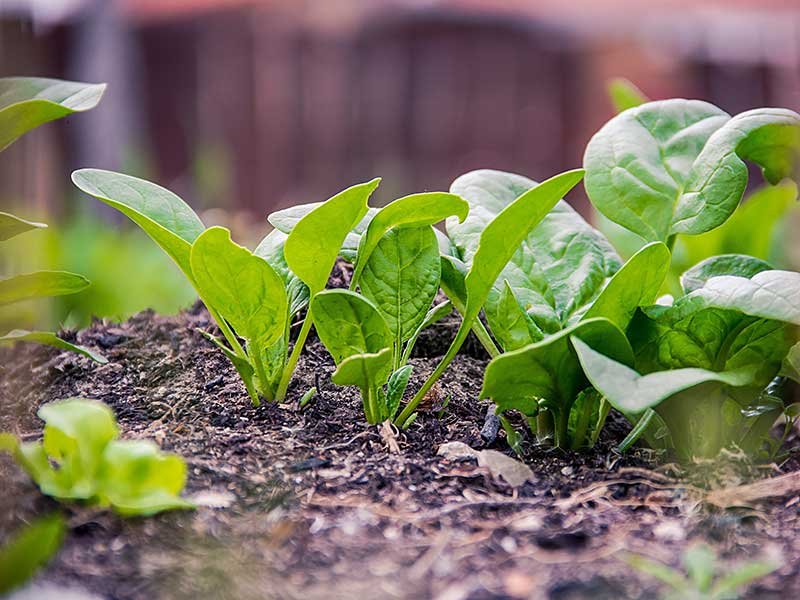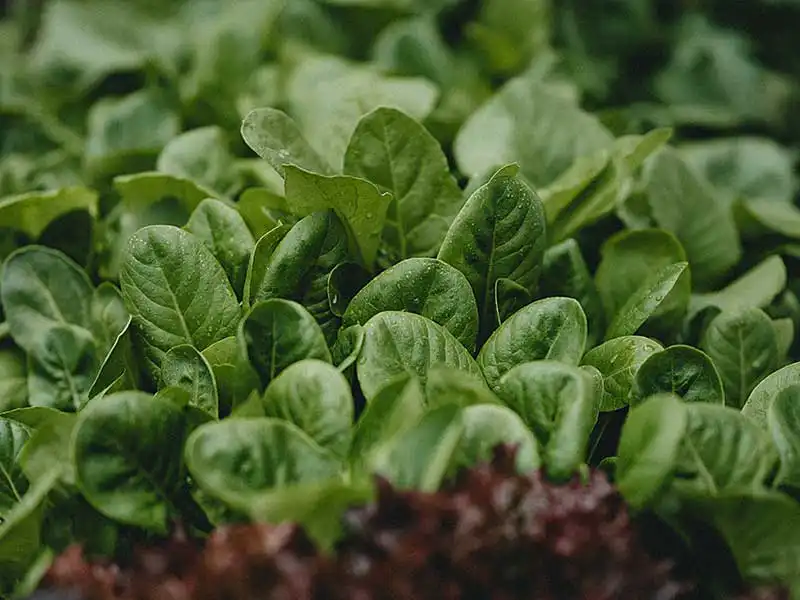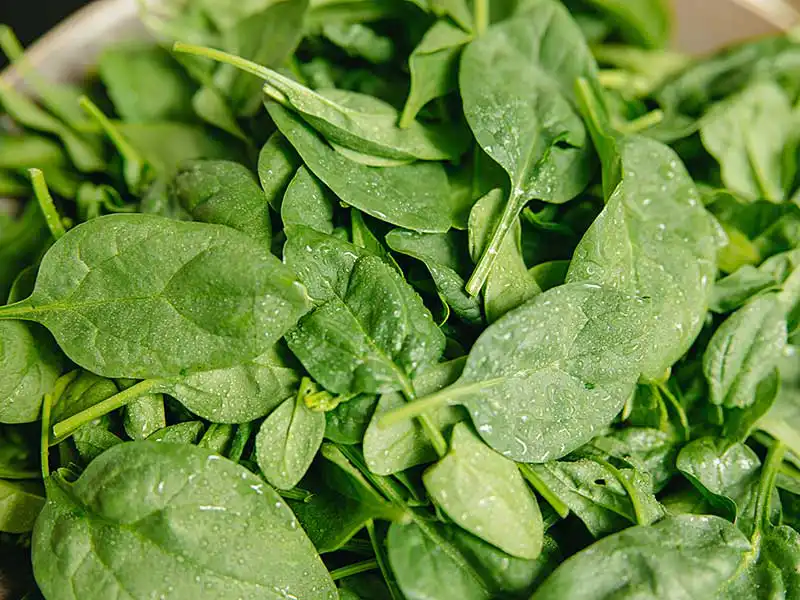Vegetable Gardening
Healthy Harvest: How to Grow Spinach in Containers
Growing spinach in containers is a fantastic way to enjoy fresh, leafy greens year-round, regardless of your space limitations. Container gardening is a great option for those who lack a traditional garden plot or for those who prefer the convenience of having their vegetables in easy-to-reach locations. In this article, we’ll guide you through the steps needed to grow spinach in containers, from selecting the perfect container to harvesting your crop.
Container selection
If you want to grow spinach in containers, it’s important to use the appropriate size. The container should also have adequate drainage holes to prevent waterlogging.
There are various container materials to choose from, including plastic, ceramic, and clay. Grow bags and plastic containers are lightweight and easy to move, while ceramic and clay containers provide better insulation. Whichever material you choose, ensure that the container is large enough to hold the soil and has enough space for the spinach plants to grow.
Best Size to Grow Spinach in Containers
Spinach needs ample space for its roots to grow, so it’s important to choose a container that is at least 6 inches deep. The container should also be wide enough to hold several plants, as spinach plants need room to spread out. A container that is 18-24 inches in diameter should be sufficient for growing multiple spinach plants.
Soil selection
The soil you choose for your spinach container is crucial to your plant’s growth and development. Spinach thrives in well-draining soil that is rich in organic matter. A good soil mix should contain equal parts of potting soil, compost, and perlite. Mix these ingredients thoroughly to ensure that they are well combined and aerated.
Before filling your container with soil, ensure that you place a layer of gravel or small stones at the bottom. This helps to improve drainage and prevents soil from blocking the drainage holes.
Cultivars: Grow Spinach In Containers
When choosing spinach cultivars for container gardening, it’s important to select varieties that are well-suited to small spaces. Here are some popular cultivars to consider:
- Bloomsdale: A baby leaf spinach that is fast-growing and perfect for container gardening.
- Space: A compact spinach that takes up less space than traditional varieties.
- Tyee: A heat-tolerant spinach that produces large, flavorful leaves.
Planting spinach

Spinach seeds can be sown directly into the container, or you can start them indoors and transplant them later.
Start Spinach Seeds Outdoors Directly in Your Container
Begin by filling your container with a high-quality potting mix that is rich in organic matter. Then, make small holes in the soil, about 1/4 inch deep, and place the spinach seeds in the holes, spacing them about an inch apart. Cover the seeds with soil and water gently.
Place the container in a sunny location and keep the soil consistently moist but not waterlogged. In about 7-10 days, the seeds should start to sprout. Once the seedlings have two sets of true leaves, thin them out to one plant every 3-4 inches. This will give each plant enough space to grow and mature properly.
Starting Spinach Seeds Indoors Pre-Season
Starting spinach seeds indoors is a great way to get a head start on your container garden. To begin, fill a seed tray with a high-quality seed starting mix and moisten it with water. Then, sow one seed per cell at a depth of 1/4 inch. Cover the seeds with a thin layer of soil and mist them with water. Place the seed tray in a warm, bright location, and keep the soil moist by misting it regularly. Using a humidity dome can also help ensure your trays don’t dry out.
In about 7-10 days, the spinach seeds should start to germinate. Once the seedlings have two sets of true leaves, they can be transplanted into larger containers. Be sure to harden off the seedlings by gradually exposing them to outdoor conditions before planting them in your container garden.
Watering spinach
Spinach requires consistent moisture to grow well, so it’s essential to water your container regularly. Water the container deeply, ensuring that the soil is evenly moist. Avoid overwatering, as this can cause root rot and other fungal diseases.
Fertilizing spinach
Spinach requires regular fertilization to produce healthy, flavorful leaves. You can use an organic fertilizer or a balanced water soluble fertilizer to feed your plants. Fertilize your spinach once every 2-3 weeks, following the instructions on the package.
Harvesting: Grow Spinach In Containers
Harvest your spinach once the leaves are large enough to eat. Baby spinach leaves can be harvested once they are about 2-3 inches long, while mature leaves can be harvested when they are about 6 inches long.
To harvest your spinach, use scissors to snip the outer leaves from the plant, leaving the inner leaves to continue growing. Harvesting in this manner encourages the plant to produce more leaves and ensures that you have a continuous supply of fresh, tender spinach. When you grow spinach in containers, it’s important to harvest frequently to prevent plants from crowding each other.
Companion Vegetables for Spinach

Spinach grows well with a variety of companion vegetables, including:
- Radishes: These fast-growing vegetables can be sown between spinach plants and harvested before the spinach reaches maturity.
- Carrots: Carrots and spinach have similar soil requirements, making them ideal companions in the same container.
- Lettuce: Lettuce and spinach are both cool-season vegetables that thrive in similar growing conditions.
Pests and diseases
Spinach is susceptible to various pests and diseases, including aphids, spider mites, and powdery mildew. To prevent these problems, keep your container clean and well-maintained, and inspect your plants regularly for signs of damage.
| Pest/Disease | Symptoms | Treatment |
|---|---|---|
| Leaf Miners | Serpentine tunnels on leaves and distorted growth | Remove affected leaves, encourage natural predators like parasitic wasps or apply a neem oil spray |
| Downy Mildew | Yellowing leaves with white/gray fuzz on the undersides | Remove affected leaves, improve air circulation, apply a copper fungicide |
| Powdery Mildew | White powdery spots on leaves | Remove affected leaves, improve air circulation, apply a potassium bicarbonate spray |
| Fusarium Wilt | Yellowing and wilting of lower leaves, stunted growth | Remove affected plant and soil, rotate crops, practice good sanitation |
| Aphids | Sticky residue on leaves, yellowing of leaves | Spray leaves with water to dislodge, apply insecticidal soap or neem oil spray |
| Slugs and Snails | Holes in leaves and slime trails | Handpick and remove, apply copper tape or diatomaceous earth around the container |
Prevention is the key to keeping your spinach healthy. Regularly inspect your plants, provide proper watering and fertilization, and practice good sanitation to minimize the risk of pests and diseases.
If you notice any pests or diseases, treat them immediately to prevent them from spreading to other plants. You can use an organic insecticide or fungicide to treat your plants, or you can try using natural remedies, such as neem oil or a solution of water and dish soap.
Tips to Successfully Grow Spinach in Containers
Here are some additional tips to help you grow spinach in containers:
- Place your container in a sunny location, ideally one that receives at least 6 hours of sunlight per day.
- Rotate your container regularly to ensure that all sides of the plant receive adequate sunlight.
- Harvest the outer leaves of the plant as soon as they are large enough to eat, and the plant will continue to produce new leaves for several weeks.
- If your spinach starts to bolt (produce flowers and seeds), harvest it immediately to prevent the leaves from becoming bitter.
- Keep your container clean and well-maintained to prevent the buildup of pests and diseases.
Recipes and Cooking Ideas

Spinach is a versatile vegetable that can be used in a variety of dishes, from salads to soups to smoothies. Here are some recipe ideas to inspire you:
- Spinach salad with strawberries and balsamic vinaigrette
- Spinach artichoke dip
- Spinach and feta stuffed chicken breasts
- Spinach and mushroom quiche
- Mango smoothie with spinach and banana
With these ideas and the tips provided in this article, you’ll be well on your way to growing and enjoying delicious, fresh spinach in your own container garden.
Conclusion
Growing spinach in containers for a fun and easy way to enjoy fresh, delicious greens at home. By selecting the right container, soil, and seeds, and following the steps outlined in this article, you can grow a successful crop of spinach in your own backyard or on a patio/balcony. With a little care and attention, you’ll be harvesting tender, flavorful spinach leaves in no time.
FAQ: Growing Spinach In Containers
How much spinach can you grow in a 5-gallon bucket?
You can grow eight spinach plants in a 5-gallon bucket, depending on the size of the container and the variety of spinach. Each plant can produce up to a pound of spinach. Be sure to use well-draining soil and fertilize regularly.
Can you grow spinach in a Mason jar?
While it is possible to grow spinach in a Mason jar, it is not the ideal container for this vegetable. Spinach needs ample space for its roots to grow, and a Mason jar is too small to accommodate a healthy plant.
How many spinach plants do I need for 2 people?
The number of spinach plants you need for two people depends on how often you plan to harvest and how much spinach you want to eat. As a general rule, one to three spinach plants per person should be sufficient.
How many times can you harvest from one spinach plant?
Spinach is a cut-and-come-again vegetable, which means that you can harvest it multiple times throughout the growing season. You can typically harvest spinach leaves every two to three weeks, and a single plant can produce up to six harvests per season.
How long can you keep picking spinach?
You can continue to harvest spinach leaves for several weeks or even months, depending on the variety and growing conditions. Spinach is a cut-and-come-again crop, which means that you can harvest leaves as soon as they are large enough to eat and the plant will continue to produce new leaves for several weeks. In general, you can continue to pick spinach until the plant starts to bolt or the weather becomes too hot.





